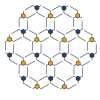Prof. Susan A Bourne, the Head of Chemistry Department, the University of Cape Town, South Africa visited us between 7 and 12 June 2017 and delivered a lecture on Chromophoric framework solids for sensing and storage.
Chromophoric framework solids for sensing and storage
Susan A. Bourne
Centre for Supramolecular Chemistry Research, Department of Chemistry, University of Cape Town
Abstract
Polymeric coordination compounds, and their subset metal-organic frameworks (MOFs) have provided a
rich source of interest to researchers in solid state functional materials.[1] The inherent porosity achievable
for 2D and 3D network structures generated from bridging ligands coordinated to metal ions allows for
applications as diverse as catalysis, gas storage, separation and extraction.[2] While interpenetration can
sometimes appear as a hindrance to engineering highly porous materials, it may hold some advantages in
terms of thermal stability and increased functionality. Thermo-, solvato- and mechanochromic coordination
networks have recently received a great deal of attention.[3-5] Materials of this type are particularly of interest
if they are able to revert to their original state on application of another external perturbation signal.
Rational design of such systems remains a challenge however, and is thus an exciting area for application
of crystal engineering principles.
While the majority of reported mechanochromic materials are based on organic molecules,[6-8] coordination
complexes or metal-organic frameworks (MOFs) are potentially attractive as stimuli-responsive devices
owing to their robust nature and the range of responses achievable.
Examples from recent work in our laboratory will be presented, including MOFs and 3D hydrogen bonded
frameworks constructed from the same flexible ditopic ligands, 4-(4-pyridyl)benzoate and 3-(4-
pyridyl)benzoate. Their chromic behaviour on application of external stimuli such as heat, grinding or
exposure to solvent vapours will be described.
References
1. Reviews: (a) A. Phan, C. J. Doonan, F. J. Uribe-Romo, C. B. Knobler, M. O’Keeffe, O. M. Yaghi, Acc. Chem. Res., 2010, 43,
58. (b) C. Janiak, J. K. Vieth, New J. Chem., 2010, 34, 2366. (c) J. J. Perry, J. A. Perman, M. J. Zaworotko, Chem. Soc.
Rev., 2009, 38, 1400. (d) Z. Chi, X. Zhang, B. Xu, X. Zhou, C. Ma, Y. Zhang, S. Liu, S, J.Xu. Chem. Soc. Rev. 2012, 41,
3878.
2. Recent examples include (a) O. K. Farha, Y. A. Oezguer, I. Eryazici, C. D. Malliakas, B. G. Hauser, M. C. Kanatzidis, S. T.
Nguyen, R. Q. Snurr, J. T. Hupp, Nat. Chem., 2010, 2, 944. (b) S. Wang, J. Lin, X. Wang, Phys. Chem. Chem. Phys. 2014,
16, 14656.
3. P-C. Guo, T-Y. Chen, X-M. Ren, Z. Chu, W. Jin, J. Mater. Chem. 2014, A 2, 13698.
4. J. Sun, C. Chen, L. Cai, C. Ren, B. Tan, J. Zhang. Chem. Commun. 2014, 50, 15956.
5. T. Wen, D-X. Zhang, J. Liu, R. Lin, J. Zhang. Chem. Commun. 2013, 49, 5660.
6. Pucci, G. Ruggeri. J. Mater. Chem. 2011, 21, 8282.
7. M.M. Caruso, D. Davis, Q. Shen, S. Odom, N.R. Sottos, S.R. White, J.S. Moore. Chem. Rev. 2009, 109, 5755.
8. K. Ariga, T. Mori, J.P. Hill. Adv. Mater. 2012, 24,158.
